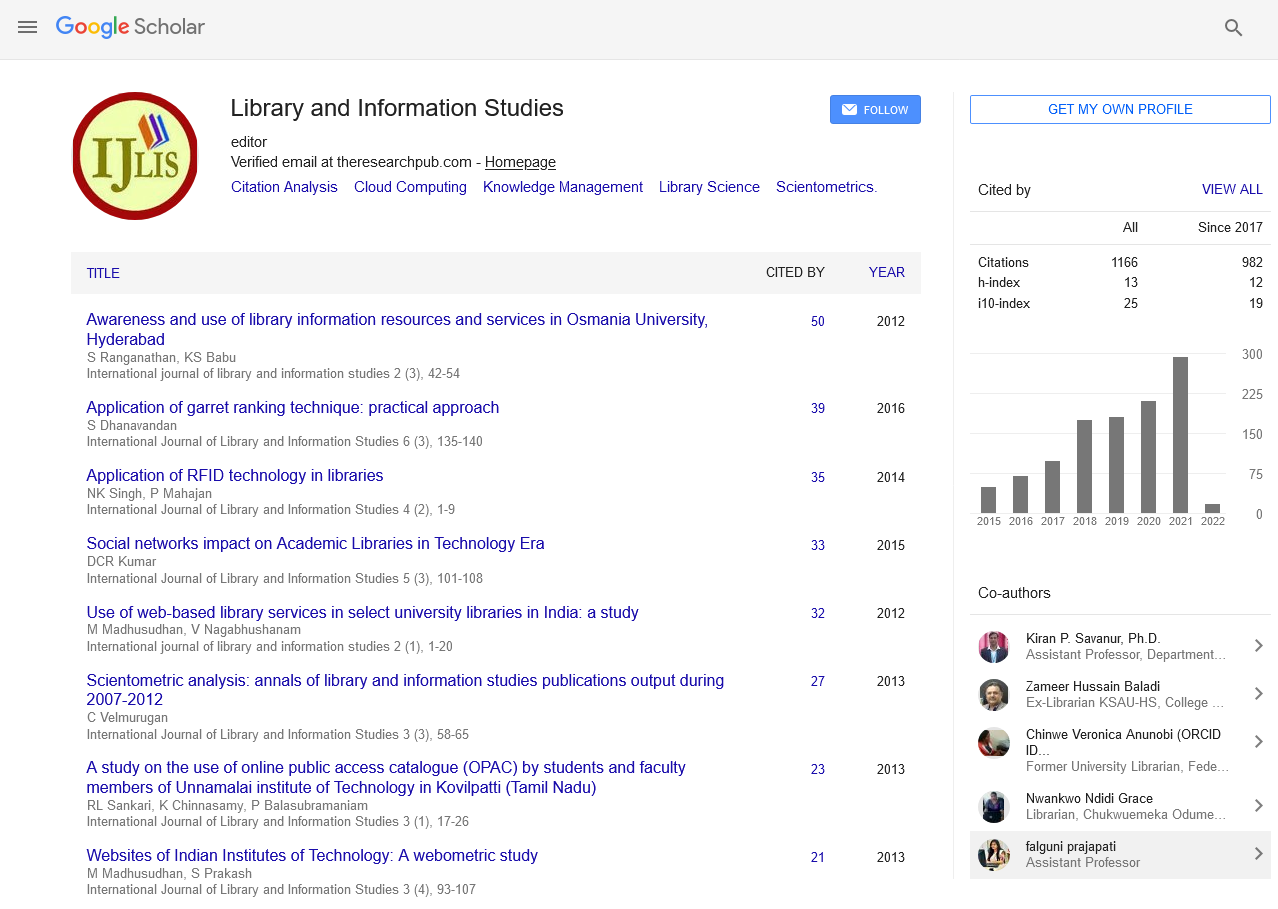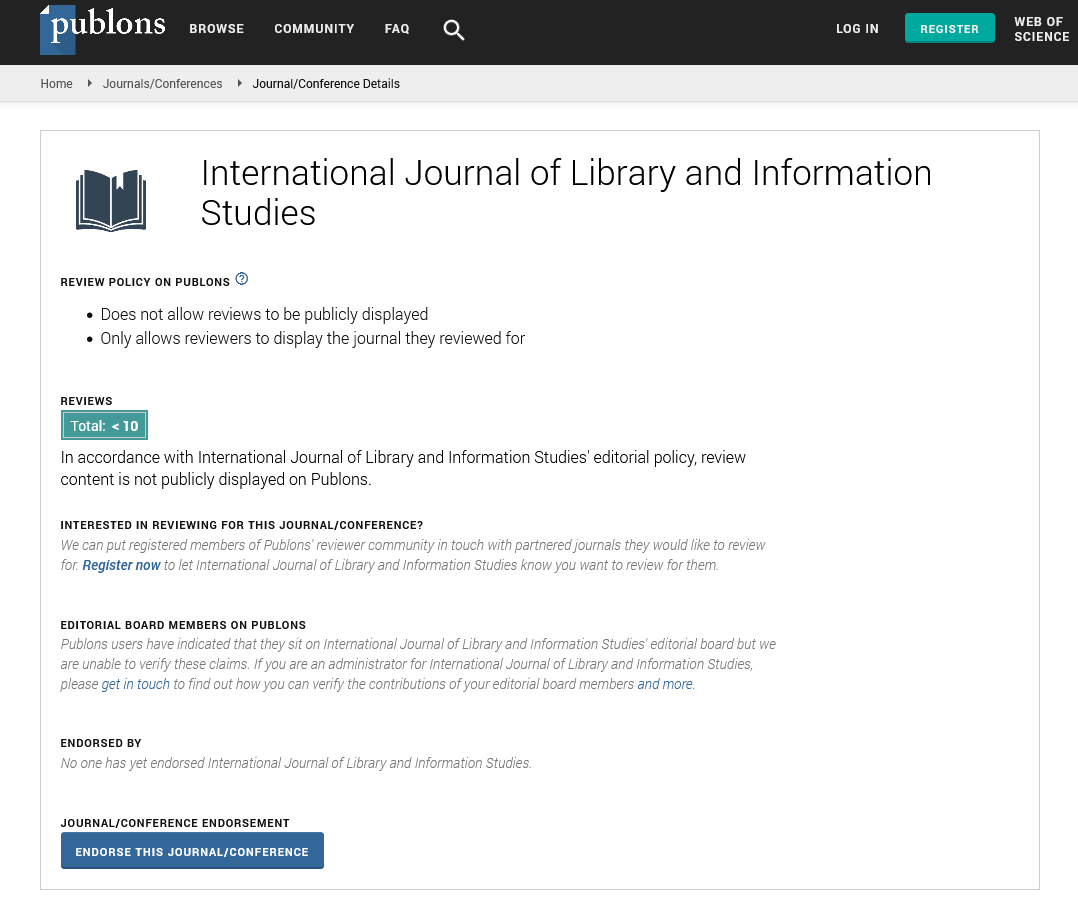Research Article - (2022) Volume 12, Issue 4
Bibliometric and Visualized Analysis of the Top 100 Most Cited Articles on Marburg Virus
Mohamed Idhris*, Manuelraj Peter*, Spurgeon Anandraj Samuel*, Abdurahiman Pattukuthu*, Helan Petricia Devasagayam*, Mohammed Barkath Ali* and Anand Pandiyarajan*Abstract
Background: The Marburg virus, also known as Marburg Hemorrhagic Fever (MHF), is closely related to the Ebola virus. The Marburg virus causes severe illness and fever, which can lead to shock or death. The study's objective is to explore the most influential 100 cited articles on the Marburg Virus.
Method: The bibliometric study was conducted using the Web of Science (WoS) database and the search words "Marburg virus" on April 26th, 2022. R-studio and Citespace (5.8.R3) were used to analysis data from the Web of Science database to identify main information, citation analysis, keyword analysis, country-wise production, and Keyword Cluster analysis of authors.
Results: A total 100 articles with the most citations out of total 1179 articles are separated for analysis. These articles appeared in 36 different publications. The number of publications is highest in the United States, followed by Germany, Switzerland, and Canada. With 22 publications, the Journal of Virology is the most widely read. The total number of citations is 4486, indicating that the Journal of Virology is the most authoritative journal in the field of Marburg virus research. The most articles were published in 1998 and 1999 (n=8 each), followed by 2000, 2009, and 2012 (n=6 each). Keywords were divided into 11 clusters: Keywords such as Marburg Virus, Ebola Virus, Hemorrhagic Fever, Glycoprotein, Infection, Protein, Identification, Disease, Gene, and Cell are frequently used this analysis.
Conclusion: Knowledge of such viruses found in any other country and large number of research articles related to newly found such viruses are mostly coming from European countries.
Keywords
Information Marburg Virus, Marburg Hemorrhagic Fever, Bibliometric Analysis, Infections.
Introduction
The Marburg virus has caused emergence and spread in Sub-Saharan Africa and is capable of causing severe illness with a high case fatality rate. In August of 1967, laboratory employees in Marburg, Germany, and Belgrade, Yugoslavia were infected with a hitherto undiscovered pathogenic agent (Aborode, et al., 2022). Initially, 3 patients with the particular associated contagious disease were admitted to the healthcare department from the College of Marburg. These people had been doing work in a Marburg vaccine plant, where vaccines and serum are created (Brauburger, et al., 2012). The three individuals had an immediate connection with the eco-friendly monkeys or their own organs (Dulin, et al., 2021). After that quickly became conscious of 3 more cases within Frankfurt that evidently got the condition in the same period. The circumstances had been similar in that will all patients experienced been handling materials from monkeys (Fedewa, et al., 2018).
The patients were treated illness was described as starting all of a sudden with extreme discomfort, myalgia, headache, and a rapid accept temperature of up to 39°C or a lot more. The source of the infection appeared to be Photography equipment green apes (Chlorocebus aethiops), The Marburg virus has emerged and spread throughout Sub-Saharan Africa, causing severe illness with a high case fatality rate (Geisbert, et al., 2010). In the month of August 1967, the etiologic agent was isolated, characterized, and determined in less than three months thanks to the collaboration of scientists from Marburg and Freie und Hansestadt Hamburg (Keshwara, et al., 2019). The pathogen was known as Marburg virus after the city with the most cases, and it even represented the first isolation of a filovirus. During the convalescence phase of the 1967 outbreak, sexual transmission was suspected because a virus antigen was detected in the patient's sperm (Longini, et al., 2022).
Review of Literature
Aborode stated his research during the Covid quickly learning from and applying the Ebola response to address the Marburg virus, Guinea Republic has strengthened their border disease surveillance to enable speedy detection and confirmation of the virus within their neighboring countries and other distant Countries. The three individuals had an immediate connection with the eco-friendly monkeys or their own organs .
Longini in his research vaccine is considered an achievement if its approximate effectiveness is greater than 50% and its precision is high enough to rule out true efficacy of less than 30%. This will necessitate approximately 150 total endpoints, or confirmed Marburg virus disease cases, per vaccine/comparator combination. Interim analyses will be performed after 50 and 100 events, respectively. The statistical analysis of the trial will be combined across the various types of designs.
Methodology
Keshwara Marburg Virus (MARV) is a virus that, like Ebola virus, causes a highly lethal hemorrhagic disease. In contrast to EBOV, only a few vaccines against MARV have been developed, and researchers do not know what types of immune responses are required to protect against MARV. Fedewa his stated that we show a filovirus genus-specific restriction to MARV in a cell line and offer the first reptile cell line that replicates a filovirus at large titer. Our findings imply that there might be distinctions between the natural host spectrum of Marburg and Ebola viruses. There is no specific treatment for Marburg virus disease. Supportive hospital therapy should be utilized, which includes balancing the patient's fluids and electrolytes, maintaining oxygen status and blood pressure, replacing lost blood and clotting factors, and treatment for any complicating infections.
Results and Discussion
Data analysis
The following incident occurred 8-10 years later, when an Australian tourist who hitchhiked through Zimbabwe was in a hospital in St. Johannesburg, South Africa, and infected two others before dying. Secondary cases are usually restored (33 percent case death rate). Following that, there have recently been reports of small MARV outbreaks in Kenya and Uganda. The largest outbreaks were in the Democratic Republic of the Congo (DRC) from 1998 to 2000, and Angola from 2004 to 2006. In the Democratic Republic of the Congo, there were 154 cases and 128 deaths. In Angola, the largest cluster involved 252 cases and 227 deaths. Throughout the Angola outbreak, it was assumed that chlamydia spread through contaminated transfusion equipment in the pediatric ward (Martini, et al., 1968) (Table 1).
| Description | Results |
|---|---|
| Main information about data | |
| Timespan | 1975:2018 |
| Sources (Journals, Books, Etc) | 36 |
| Documents | 100 |
| Average years from publication | 17.5 |
| Average citations per documents | 219.6 |
| Total citations | 21957 |
| Average citations per year per doc | 14.34 |
| References | 2830 |
| Document types | |
| Article | 86 |
| Article; Proceedings paper | 5 |
| Editorial material | 2 |
| Letter | 1 |
| Note | 1 |
| Review | 4 |
| Review; Book chapter | 1 |
| Document contents | |
| Keywords plus (ID) | 412 |
| Author's keywords (DE) | 80 |
| Authors | |
| Authors | 684 |
| Author appearances | 1012 |
| Authors of single-authored documents | 1 |
| Authors of multi-authored documents | 683 |
| Authors collaboration | |
| Single-authored documents | 1 |
| Documents per author | 0.146 |
| Authors per document | 6.84 |
| Co-authors per documents | 10.1 |
| Collaboration index | 6.9 |
Table 1: Main Information about the Data and Citations
The key information’s like total citations with coverage years, total citations, average citations, document type details, author details and author collaboration details are categorizes in the Table 1. In this analysis we have selected hundred publications with more citations for scrutiny (Figure 1).
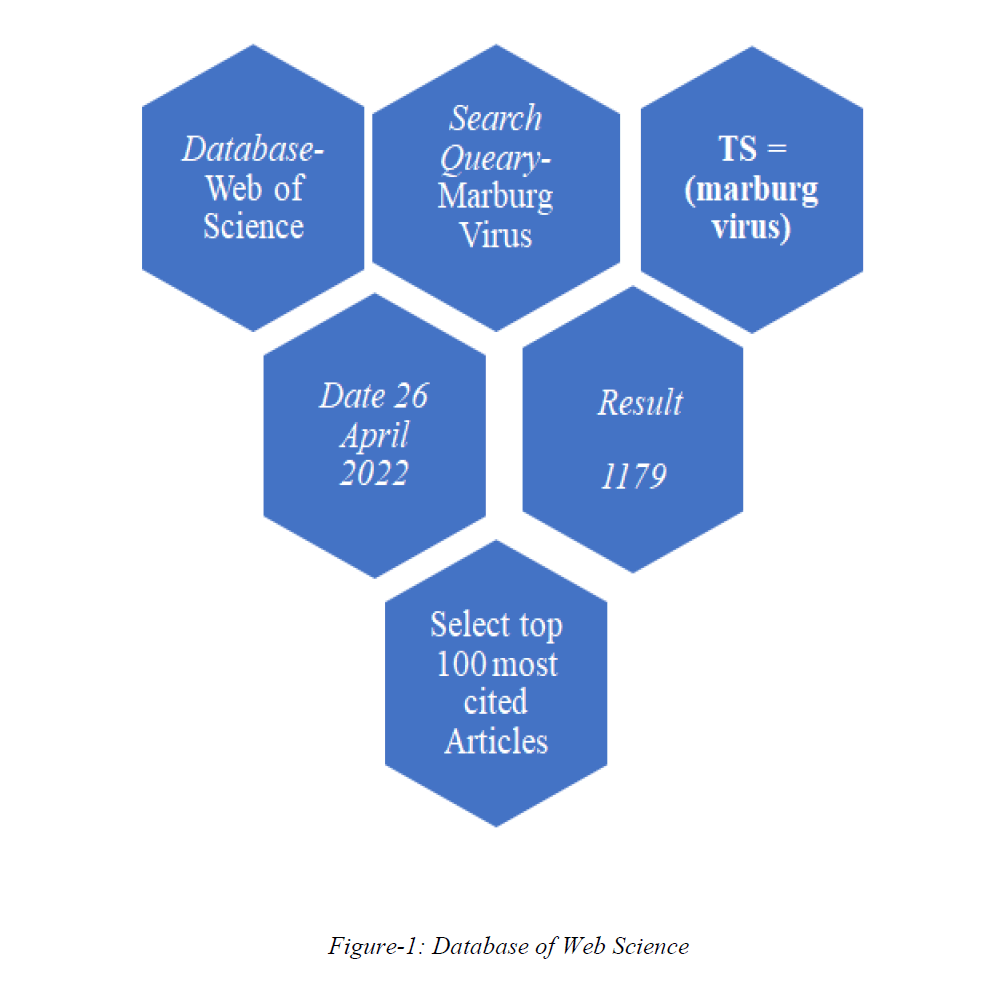
Figure-1: Database of Web Science
We analysis this article using the Web of Science (WOS) database is regarded as one of the most widely known and well established resources in citation analysis on April 26th, 2022. Key words included "Marburg Virus" with (TS=Topic Search), the total 1179 results are found with no time limitation, abstract availability, study type, or research subjects’ limitations. Following a thorough search, all retrieved articles were sorted by the number of citations. Following a thorough search, all retrieved articles were sorted by the number of citations, and more than 100 articles with more citations are being analyzed (Table 2 and Figure 2).
| Year | N | TC | MeanTC | MeanTC | Citable Years |
|---|---|---|---|---|---|
| per art | per year | ||||
| 1975 | 1 | 237 | 237 | 5.04 | 47 |
| 1982 | 1 | 228 | 228 | 5.7 | 40 |
| 1992 | 1 | 125 | 125 | 4.17 | 30 |
| 1993 | 2 | 368 | 184 | 12.69 | 29 |
| 1994 | 1 | 117 | 117 | 4.18 | 28 |
| 1995 | 3 | 601 | 200.33 | 22.26 | 27 |
| 1996 | 3 | 749 | 249.67 | 28.81 | 26 |
| 1997 | 1 | 433 | 433 | 17.32 | 25 |
| 1998 | 8 | 1741 | 217.63 | 72.54 | 24 |
| 1999 | 8 | 1772 | 221.5 | 77.04 | 23 |
| 2000 | 6 | 1351 | 225.17 | 61.41 | 22 |
| 2001 | 3 | 604 | 201.33 | 28.76 | 21 |
| 2002 | 4 | 892 | 223 | 44.6 | 20 |
| 2003 | 5 | 1340 | 268 | 70.53 | 19 |
| 2004 | 4 | 848 | 212 | 47.11 | 18 |
| 2005 | 4 | 842 | 210.5 | 49.53 | 17 |
| 2006 | 3 | 490 | 163.33 | 30.63 | 16 |
| 2007 | 4 | 740 | 185 | 49.33 | 15 |
| 2008 | 1 | 144 | 144 | 10.29 | 14 |
| 2009 | 6 | 1376 | 229.33 | 105.85 | 13 |
| 2010 | 4 | 724 | 181 | 60.33 | 12 |
| 2011 | 5 | 2084 | 416.8 | 189.45 | 11 |
| 2012 | 6 | 998 | 166.33 | 99.8 | 10 |
| 2013 | 3 | 420 | 140 | 46.67 | 9 |
| 2014 | 2 | 488 | 244 | 61 | 8 |
| 2015 | 5 | 1278 | 255.6 | 182.57 | 7 |
| 2016 | 4 | 707 | 176.75 | 117.83 | 6 |
| 2017 | 1 | 148 | 148 | 29.6 | 5 |
| 2018 | 1 | 112 | 112 | 28 | 4 |
| Grand Total | 100 | 21957 |
Table 2: Citation Analysis and Topic Search per Year
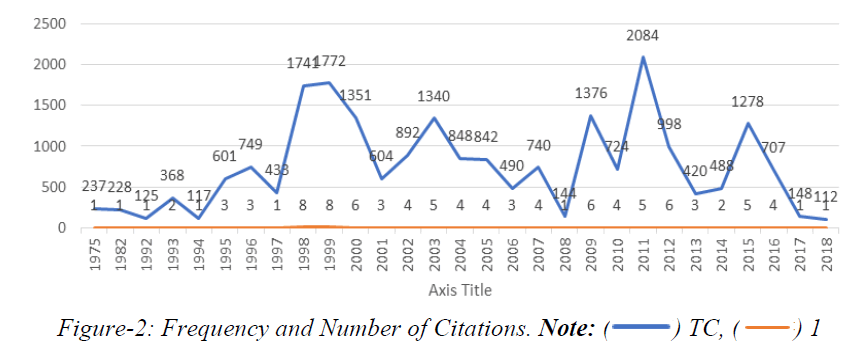
Figure-2: Frequency and Number of Citations.
Table 2 shows the frequency and number of citations, as well as the average number of citations and the number of citable years. The first article, with (n=1) 237 citations, was published in 1975 after the 100 most frequently cited papers were identified. The citation frequency of works written after 1975 had increased dramatically in comparison to earlier years. None of the papers published in the next six years, from 1976 to 1981 and 1983 to 1991, ranked in the top 100 due to the low number of citations. We also discovered that 2011 had the most overall citations (n=5), followed by 1999 (n=8) (Table 3).
| Source | Free | Citation | % |
|---|---|---|---|
| Journal of Virology | 22 | 4486 | 20.43 |
| Journal of Infectious Diseases | 10 | 1799 | 8.19 |
| Proceedings of The National Academy of Sciences of The United States of America | 8 | 2456 | 11.19 |
| Virology | 8 | 1534 | 6.99 |
| Lancet | 4 | 1700 | 7.74 |
| Emerging Infectious Diseases | 3 | 432 | 1.97 |
| Nature | 3 | 1318 | 6 |
| Nature Medicine | 3 | 772 | 3.52 |
| Plos Pathogens | 3 | 692 | 3.15 |
| Virus Research | 3 | 565 | 2.57 |
| Cell | 2 | 237 | 1.08 |
| Embo Journal | 2 | 356 | 1.62 |
| Jama-Journal of The American Medical Association | 2 | 629 | 2.86 |
| Molecular Cell | 2 | 514 | 2.34 |
| New England Journal of Medicine | 2 | 420 | 1.91 |
Table 3: Top Sources with Highly Citations
The journal of Virology (n=22) received the most citations for Marburg virus research, with 4486 citations, followed by the Journal of Infectious Diseases, which received 1799 citations with 10 frequencies (Table 4).
| Rank | Occurrences | Keyword |
|---|---|---|
| 1 | 55 | Marburg Virus |
| 2 | 25 | Ebola Virus |
| 3 | 20 | Hemorrhagic Fever |
| 4 | 19 | Glycoprotein |
| 5 | 18 | Infection |
| 6 | 12 | Protein |
| 7 | 11 | Identification |
| 7 | 11 | Disease |
| 8 | 10 | Gene |
| 9 | 8 | Cell |
| 10 | 7 | Nonhuman Primate |
| 10 | 7 | Vesicular Stomatitis Virus |
| 10 | 7 | Messenger RNA |
| 10 | 7 | Outbreak |
| 10 | 7 | Human Immunodeficiency Virus |
| 11 | 6 | Rhesus Monkey |
| 11 | 6 | Congo |
| 11 | 6 | Postexposure protection |
| 11 | 6 | Dendritic Cell |
| 11 | 6 | Double Stranded RNA |
| 11 | 6 | Guinea Pig |
| 11 | 6 | Ebola |
| 12 | 5 | Receptor |
| 12 | 5 | Antibody |
| 12 | 5 | Replication |
| 12 | 5 | Filovirus |
| 12 | 5 | Ebola Hemorrhagic Fever |
| 12 | 5 | Dc Sign |
| 12 | 5 | Transcription |
| 12 | 5 | Monkey |
| 13 | 4 | Endothelial Cell |
| 13 | - | Marburg Virus Disease |
| 13 | 4 | Haemagglutinin |
| 13 | 4 | Kikwit |
| 13 | 4 | Electron Microscopy |
| 13 | 4 | Expression |
| 13 | 4 | Marburg |
| 13 | 4 | Response |
| 13 | 4 | Cellular Entry |
| 14 | 3 | Envelope Protein |
| 14 | 3 | Nucleotide Sequence |
| 14 | 3 | Domain |
| 14 | 3 | Mouse Model |
| 14 | 3 | Protects Nonhuman Primate |
| 14 | 3 | Hendra Virus |
| 14 | 3 | Vaccination |
| 14 | 3 | System |
| 14 | 3 | Live |
| 14 | 3 | Mechanism |
| 14 | 3 | Immunity |
Table 4: Keyword Analysis in Different Infectious Diseases
The top 100 most cited publications yielded 492 total keywords (keywords plus 412 and author's keyword 80). The 50 keywords that were mentioned three keywords or more were listed in Table 4 (Reynolds, et al., 2017). Marburg Virus was the top-ranking keyword in the over all, with 55 Occurrences. Thus, there are fourteen rank orders created from the total of fifty keywords. In this table 14th rank have the most number of keywords with 11 numbers (Table 5).
| Cluster | Size | Mean | Label (LSI) | Label (LLR) | Label (MI) |
|---|---|---|---|---|---|
| ID | (Year) | ||||
| 0 | 49 | 2001 | glycoprotein, virus, protein, endocytosis, cholesterol | guinea pig, infection, prophylaxi, replication competent, ebola | Cell, entry, cholesterol, tumor necrosis factor, membrane association | viral receptor, element, smallpox |
| 1 | 43 | 2008 | hemorrhagic fever, viral disease, guinea pig, small molecule, infection | immunity, response, prophylaxi, model, macaque | hemorrhagic fever, immunity, mouse model, challenge, nonhuman primate | double blind, hamster, antiviral active |
| 2 | 38 | 2001 | marburg virus, zaire, glycoprotein, filovirus, immunization | fluorogenic 5 nuclease assay, hemorrhagic fever, lassa fever, diagnosis, rapid detection | Zaire, filovirus, experimental infection, rhesus monkey, lassa fever | bind, complex, west Africa |
| 3 | 36 | 2007 | marburg virus, congo, postexposure protection, persistent infection, virus infection | ebola virus, hendra virus, nipah virus, emerging infectious diseases, bat origin | congo E-, outbreak E-kikwit, E-reemergence, Marburg virus disease |
philippine, hendra virus in flying-foxes |
| 4 | 32 | 1998 | ebola virus, vpu protein, cell surface, particle, hiv 1 vpu | replication, identification, gene, envelope protein, ebola | domain, particle, fusion, glycosylation, replication | linked n acetylglucosamine, envelope |
| 5 | 32 | 1997 | gene, envelope protein, identification, vpu protein, cell surface | ebola virus, marburg virus, herpes simplex virus 1, expression, cloned cdna | respiratory syncytial virus, p protein, genome replication, gene, expression | terminal domain, l polymerase protein |
| 6 | 25 | 2005 | marburg virus, herpes simplex virus 1, influenza a virus, ns1 protein, double stranded rna | nf kappa, matrix protein, vesicular stomatitis, tyrosine kinase, antiviral response | double stranded RNA, NF kappa b, cellular entry, endothelial cell, i interferon | transcription factor, influenza |
| 7 | 25 | 1998 | atomic structure, escherichia coli, coiled coil, hemagglutinin, HIV 1 gp41 | complete nucleotide, cdna clone, late assembly, rous sarcoma, atomic structure | hemagglutinin, membrane fusion, messenger RNA, gag protein, pathogenicity | gag protein, pathogenicity, conforma |
| 8 | 23 | 2004 | infection, marburg virus, primate, influenza a virus, cdna | alphavirus, replicon, ebola, infection, duck rubella | infection, activation, lipid raft microdomain, t cell response, vp | lipid raft microdomain, t cell response |
| 9 | 22 | 2008 | haemorrhagic fever, electron microscopy, ebola virus, hepatitis c virus, cationic amphiphiles | sars coronavirus, human immunodeficiency virus, attachment factor, hepatitis c virus, cationic amphiphiles | haemorrhagic fever, calcium channels, cationic amphiphiles, autopsy, pathology | calcium channels, cationic amphiphiles |
| 10 | 11 | 2001 | c-type lectin, asialoglycoprotein receptor, subunit h1, carbohydrate recognition domain, x-ray crystal structure | x-ray crystal structure, c-type lectin, carbohydrate recognition domain, subunit, asialoglycoprotein receptor | marburg virus, ebola virus, x-ray |
| Note: LSI: Latent Semantic Indexing; LLR: Log Likelihood Ratio; MI: Mutual Information. | |||||
Table 5: Keyword Cluster Analysis by LSI, LLR, and MI
The above Table 5 is divided by 10 clusters. These all clusters have divided by three Labels like LSI-Latent Semantic Indexing, LLR-LogLikelihood Ratio, MI-Mutual Information. The Cluster ID Zero has highest number of clusters. (n=49) followed by cluster one has forty-three size. The remaining clusters have similar cluster sizes (Figure 3 ).
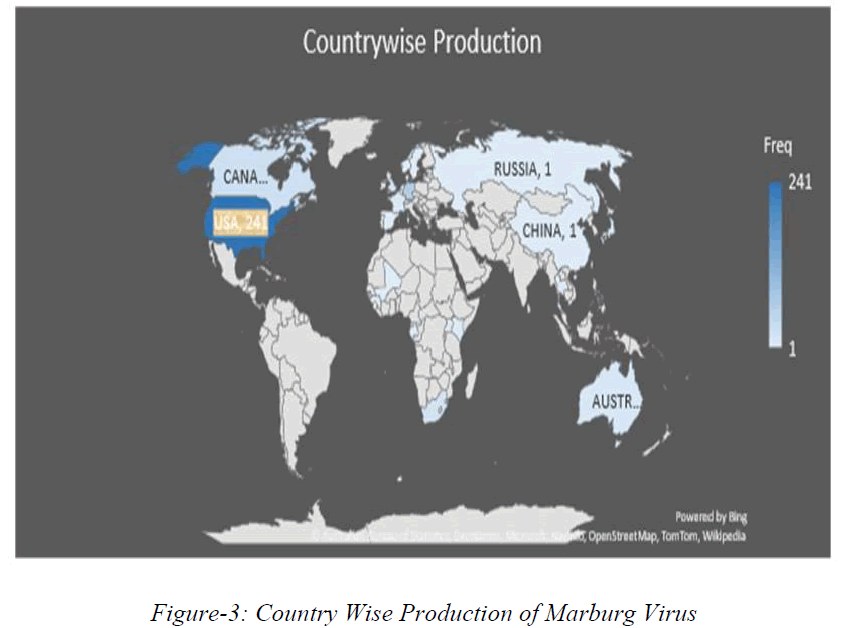
Figure-3: Country Wise Production of Marburg Virus
In Table 6, it has displayed country wise production in the research of Marburg virus. At the end of this overall research the United States of America got first ranks with 241 frequencies followed by Germany has second rank with 63 frequencies and Switzerland has 32 frequencies with third ranks (Table 6).
| Region | Frequencies |
|---|---|
| USA | 241 |
| Germany | 63 |
| Switzerland | 32 |
| Canada | 24 |
| South Africa | 18 |
| UK | 17 |
| Japan | 13 |
| Netherlands | 11 |
| Australia | 10 |
| France | 8 |
| Uganda | 7 |
| Belgium | 4 |
| Kenya | 4 |
| Gabon | 3 |
| Denmark | 2 |
| Guinea | 2 |
| Norway | 2 |
| Austria | 1 |
| China | 1 |
| Mali | 1 |
| Philippines | 1 |
| Russia | 1 |
| Sierra Leone | 1 |
| Singapore | 1 |
| Spain | 1 |
| Sweden | 1 |
| Thailand | 1 |
Table 6: Country Wise Distribution and Frequencies
The recent Ebola virus outbreak in West Africa highlighted the danger filoviruses represent. 11,323 people died and 28,646 were infected with the Ebola virus during the three-year outbreak (Suschak, et al., 2019). As per the current situation, new viruses like Ebola and corona are spreading around the world and causing people a lot of suffer (Siegert, et al., 1968). Over the past few years, significant progress has been made in creating viable Marburg virus vaccines (Towner, et al., 2016). Despite a recent pandemic in Uganda and the astonishingly high mortality rate among Marburg illness victims, there are still many gaps in our understanding of Marburg infection vaccinations (Vanmechelen, et al., 2021). Clinical preliminary studies on the vaccination against human Marburg infection are currently scarce, and those that have been conducted have had poor immunogenicity. The findings in this research may help with the urgent need to create a safe, efficient Marburg virus vaccine, which could help to stop the spread of this deadly virus and shield communities all over the world from this threat (Wan, et al., 2020).
Conclusion
The research is based on the Bibliometric study on the Marburg virus, using Citespace and RStudio software for visual analysis. This research on the Marburg Virus is generally increasing year after year. Globally, the United States, China, and Germany are the top three countries in this study. It is necessary for various countries to enhance their exchanges and collaboration. Among the research Sources, Journal of Virology is the highest influence on achievements with (n=22). As a result, we must expand research into this type of virus and disease transmission. Future directions include effective drug therapy and vaccine research.
References
- Aborode, Abdullahi Tunde. "Marburg virus amidst COVID‐19 pandemic in Guinea: Fighting within the looming cases." Int J Health Plann Manage 37.1 (2022): 553.
[Cross Ref] [Google Scholar] [Pub Med]
- Brauburger, Kristina. "Forty-five years of Marburg virus research." Viruses 4.10 (2012): 1878-1927.
[Cross Ref] [Google Scholar] [Pub Med]
- Dulin, Nicholas. "Systematic review of Marburg virus vaccine nonhuman primate studies and human clinical trials." Vaccine 39.2 (2021): 202-208.
[Cross Ref] [Google Scholar] [Pub Med]
- Fedewa, Greg, et al. "Ebola virus, but not Marburg virus, replicates efficiently and without required adaptation in snake cells." Virus Evol 4.2 (2018): vey034.
[Cross Ref] [Google Scholar] [Pub Med]
- Geisbert, Thomas W., Daniel G. Bausch, and Heinz Feldmann. "Prospects for immunisation against Marburg and Ebola viruses." Rev Med Virol 20.6 (2010): 344-357.
[Cross Ref] [Google Scholar] [Pub Med]
- Keshwara, Rohan. "A recombinant rabies virus expressing the Marburg virus glycoprotein is dependent upon antibody-mediated cellular cytotoxicity for protection against Marburg virus disease in a murine model." Virol J 93.6 (2019): e01865-18.
[Cross Ref] [Google Scholar] [Pub Med]
- Longini, Ira M. "A platform trial design for preventive vaccines against Marburg virus and other emerging infectious disease threats." Clinical Trials (2022): 17407745221110880.
[Cross Ref] [Google Scholar] [Pub Med]
- Martini, Gustav Adolf. "Marburg virus disease. Clinical syndrome." Marburg Virus Disease. Springer, Berlin, Heidelberg, 1971. 1-9.
- Martini, G. A., and H. A. Schmidt. "Spermatogenic transmission of the" Marburg virus"(Causes of" Marburg simian disease")." Klinische Wochenschrift 46.7 (1968): 398-400.
[Cross Ref] [Google Scholar] [Pub Med]
- Reynolds, Pierce, and Andrea Marzi. "Ebola and Marburg virus vaccines." Virus Genes 53.4 (2017): 501-515.
[Cross Ref] [Google Scholar] [Pub Med]
- Suschak, John J., and Connie S. Schmaljohn. "Vaccines against Ebola virus and Marburg virus: recent advances and promising candidates." Hum Vaccines Immunother 15.10 (2019): 2359-2377.
[Cross Ref] [Google Scholar] [Pub Med]
- Siegert, R. "The aetiology of an unknown human infection transmitted by monkeys (preliminary communication)." German Medical Monthly 13.1 (1968): 1-2.
- Towner, Jonathan S. "Marburgvirus genomics and association with a large hemorrhagic fever outbreak in Angola." J Virol 80.13 (2006): 6497-6516.
[Cross Ref] [Google Scholar] [Pub Med]
- Vanmechelen, Bert. "Advancing Marburg virus antiviral screening: Optimization of a novel T7 polymerase-independent minigenome system." Antiviral Res 185 (2021): 104977.
[Cross Ref] [Google Scholar] [Pub Med]
- Wan, William. "Ebola and Marburg virus matrix layers are locally ordered assemblies of VP40 dimers." Elife 9 (2020): e59225.
[Cross Ref] [Google Scholar] [Pub Med]
Author Info
Mohamed Idhris*, Manuelraj Peter*, Spurgeon Anandraj Samuel*, Abdurahiman Pattukuthu*, Helan Petricia Devasagayam*, Mohammed Barkath Ali* and Anand Pandiyarajan*Received: 09-Nov-2022, Manuscript No. IJLIS-22-79342; Editor assigned: 14-Nov-2022, Pre QC No. IJLIS-22-79342 (PQ); Reviewed: 06-Dec-2022, QC No. IJLIS-22-79342; Revised: 13-Dec-2022, Manuscript No. IJLIS-22-79342(R); Published: 20-Dec-2022, DOI: 10.35248/2231-4911.22.12.841
Copyright: This is an open access article distributed under the terms of the Creative Commons Attribution License, which permits unrestricted use, distribution, and reproduction in any medium, provided the original work is properly cited.
Call for Papers
Authors can contribute papers on
What is Your ORCID
Register for the persistent digital identifier that distinguishes you from every other researcher.
Social Bookmarking
Know Your Citation Style
American Psychological Association (APA)
Modern Language Association (MLA)
American Anthropological Association (AAA)
Society for American Archaeology
American Antiquity Citation Style
American Medical Association (AMA)
American Political Science Association(APSA)



